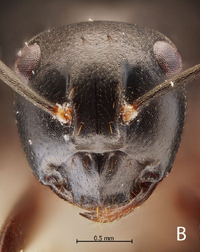Polyrhachis lao
| Polyrhachis lao | |
|---|---|

| |
| Scientific classification | |
| Kingdom: | Animalia |
| Phylum: | Arthropoda |
| Class: | Insecta |
| Order: | Hymenoptera |
| Family: | Formicidae |
| Subfamily: | Formicinae |
| Tribe: | Camponotini |
| Genus: | Polyrhachis |
| Subgenus: | Campomyrma |
| Species: | P. lao |
| Binomial name | |
| Polyrhachis lao Jaitrong & Yamane, 2023 | |
The Lao specimens (colony WJT10-LAO-42) of Polyrhachis lao were collected from a plantation. The nest was in a dead wood hanging on a shrub.
Photo Gallery
Identification
Polyrhachis lao is most similar to Polyrhachis halidayi, from which the former is easily separated by the characteristics mentioned in the key.
It is similar to the species of the Polyrhachis xiphias group in sharing the condition of median clypeal carina, but in the P. xiphias-group the dorsal ridge of the petiole between the lateral spines is entire, without median spines or denticles.
Khachonpisitsak et al. (2020) treated this species as Polyrhachis shixingensis of the P. xiphias-group, a larger species recorded from China and Vietnam, but the treatment was based on misidentification. Polyrhachis lao is also similar to Polyrhachis quadrispinosa; differences between the two species are given in the key.
Keys including this Species
Distribution
The report of Polyrhachis shixingensis from Thailand is a misidentification of this species (Jaitrong et al., 2023).
Latitudinal Distribution Pattern
Latitudinal Range: 18.3° to 16.5°.
| North Temperate |
North Subtropical |
Tropical | South Subtropical |
South Temperate |
- Source: Jaitrong et al., 2023
Distribution based on Regional Taxon Lists
Oriental Region: Laos (type locality), Thailand.
Distribution based on AntMaps
Distribution based on AntWeb specimens
Check data from AntWeb
Countries Occupied
| Number of countries occupied by this species based on AntWiki Regional Taxon Lists. In general, fewer countries occupied indicates a narrower range, while more countries indicates a more widespread species. |

|
Estimated Abundance
| Relative abundance based on number of AntMaps records per species (this species within the purple bar). Fewer records (to the left) indicates a less abundant/encountered species while more records (to the right) indicates more abundant/encountered species. |

|
Biology
Castes
Nomenclature
The following information is derived from Barry Bolton's Online Catalogue of the Ants of the World.
- lao. Polyrhachis lao Jaitrong & Yamane, in Jaitrong et al., 2023: 303, figs. 1B, 6 (w.) LAOS.
Unless otherwise noted the text for the remainder of this section is reported from the publication that includes the original description.
Description
Worker
(Holotype and paratypes, n = 10): TL 5.40–5.56, HL 1.40–1.80, HW1 1.32–1.64, HW2 1.64–1.80, SL 1.64–1.80, ML 1.84–2.20, PW 0.96–1.08, MTL 1.28–1.36, CI 90–94, SI 107–124.
Head in full-face view slightly longer than broad (CI 90–94) with posterior margin broadly convex, lateral margin weakly convex. Frontal lobe in full-face view narrow, not covering antennal socket. Frontal carina in profile view elevated, in full-face view weakly sinuate, and reaching level of mid-length of eyes; median line ill developed, attaining level of anterior margins of eye. Clypeus in full-face view broad and weakly convex, anteriorly broadly truncate with rugged anterior margin, posteriorly broadly convex with posteromedian portion rather straight and medially weakly concave; in profile clypeus weakly convex, with well-marked median ridge. Mandible elongate-subtriangular, i.e., outer and inner margins only slightly diverging apicad; its masticatory margin with 5 distinct teeth (including smallest basal and largest apical teeth). Antennal scape clavate, relatively long, about 1.10–1.24 times as long as head width (SI 107–124) including eyes. Eye in full-face view weakly convex, located just anterior to posterolateral corner of head; its outer margin reaching lateral margin of head.
Mesosoma box-like, its dorsum distinctly marginate along entire length. Dorsum of pronotum flat, broader than long, distinctly narrowed posteriad, with anterolateral corner roundly convex and marginate, without any projection or spine; anterior margin gradually sloping to pronotal lobe; posterior margin shallowly emarginate; lateral face of pronotum in profile subtriangular. In dorsal view, mesonotum clearly longer than broad, lateral margin weakly convex; in lateral view mesopleuron flat, demarcated from metapleuron by distinct groove; lower portion of mesopleuron anteriorly with carinate free margin; metapleuron not clearly demarcated from lateral face of propodeum. Propodeal dorsum excluding spines almost as long as broad or slightly longer than broad, and distinctly concave; propodeum with long spines, in profile view almost as long as width at base and pointed backward. Petiole dorsally with two long lateral spines and two rudimentary median denticles.
Dorsum of head, clypeus, and antenna finely micropunctate; basal half of mandible micropunctate, apical half somewhat smooth and shiny; mesosoma and legs entirely micropunctate except for mesonotum (in some specimens) with imbricate-reticulate; lateral face of mesosoma slightly shiny compared with dorsum; gaster finely micropunctate.
Dozens of brown erect hairs present along anterior clypeal margin; 3–4 erect hairs present along each frontal carina; vertex with two erect hairs; mesosoma, petiole, and first gastral tergite without erect hairs; second to fourth gastral tergites with sparse short erect hairs; gastral sternites with sparse long hairs; tip of gaster with some hairs. Body black to dark brown; antennae and legs reddish brown.
Type Material
- Holotype worker (THNHM-I-00027051, THNHM), central Laos, Vientiane Province, Naxythong District, Sivilay Village, 18º15′′N, 102º27′E, 9.VI.2010, Sk. Yamane leg., LA10-SKY-021.
- Paratypes: 5 workers (THNHMI-00027052 to THNHM-I-00027054, THNHM; SKY090610-1 to SKY090610-2, SKYC), same data as holotype; 8 workers (THNHM-I-00027055 to THNHM-I-00027062, THNHM), central Laos, Vientiane Province, Naxythong District, Sivilay Village, from dead wood, 9.VI.2010, W. Jaitrong leg., WJT10-LAO-42.
Etymology
The specific epithet, lao, refers to its type locality in Laos.
References
- Jaitrong, W., Yamane, S., Samung, Y., Noon-anant, N. 2023. The ant subgenus Campomyrma of the genus Polyrhachis Smith, 1857 (Hymenoptera, Formicidae, Formicinae) in Thailand and Laos, with descriptions of two new species. Zootaxa 5271(2), 294–312 (doi:10.11646/zootaxa.5271.2.5).
- Khachonpisitsak, S., Yamane, S., Sriwichai, P., Jaitrong, W. 2020. An updated checklist of the ants of Thailand (Hymenoptera, Formicidae). ZooKeys 998, 1–182 (doi:10.3897/zookeys.998.54902).
